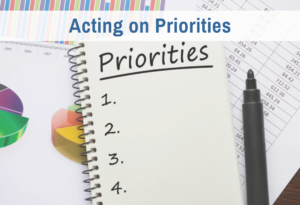I didn’t set out to teach time management, but I sure talk about it a lot in my programs. That’s because each aspect of a time-management system takes firsthand thinking to make it work.
Consider the first basic problem in time management: keeping track of what you need to do when. You need a calendar, a “to-do” list, a filing system. Each of them serves a specific purpose. Together they are supposed to reduce overload, reduce the need to remember things, and make it easier to figure out what to do next. When you read books on time management, you learn many clever tools to help with this.
But what if when you use a tool, you still feel overloaded? Or you can’t remember where to put things in your system? Or it’s even harder to figure out what to do?
Simply put, there is no one-mind-fits-all solution for keeping track of tasks and to-do’s. You need to test-drive any solution to see how it will help you do your particular work. When you try it, observe what happens introspectively, and if needed, adjust the approach. This experimentation is the key to figuring out what you truly need in your system. You may bog down or go in circles, but if you keep that experimental mindset, you will learn something important about managing your work.
For example, years ago, at the advice of David Allen, I tried compiling one huge “next action” list. It had 150 items on it. I quickly found that I didn’t want to look at the list because I felt overwhelmed by it. From that experiment, I discovered that I work much better with hierarchical lists, so that I’m never looking at a list of more than 20 items.
The second basic area of time management is scheduling. I like to say you need a scheduling infrastructure — a basic structure for your day in which you can plunk specific work blocks. No one else can figure out what basic structure will work for you. You need to know, not just the kind of work you have to do, but what kind of mental energy you have available in the morning versus after lunch versus in the evening. You need to know when you need breaks and what distractions to work around.
A good structure for your schedule is a brilliant piece of engineering. It minimizes transition costs, it maximizes your motivation for each item as you come to it, and it remains flexible enough that you can handle last-minute changes without having your productivity go kaput. It takes a fair amount of experimenting!
If your reaction to having a schedule is “ugh!” and you hate to be boxed in, then that’s exactly why you need to think about this issue. If a standard schedule doesn’t appeal to you, you need to do some creative thinking to decide how you’ll get the benefits of predictability by some other means.
And…it can still be worth experimenting with approaches that seem appalling if you have a good reason for trying them out. Last year, I experimented extensively with working on a calendar, quite contrary to my usual approach. I calendared every task and then did my best to stick to the schedule. I was persuaded to try this approach because it was supposed to develop a rock-solid confidence about when I would get things done.
I got better at predicting how much time different tasks take. I figured out important boundaries for my schedule. But in the end, the calendaring approach did not build confidence; it created a different set of problems. I don’t regret experimenting with it because I came out with a new appreciation of just how much creative thinking I do — and how much flexibility I need to keep those creative projects on track.
Finally, there is a third issue. To make a time-management system work, you need to make decisions. Many decisions. Decisions about priorities, decisions about means and ends, decisions about whether you’re finished with something. Decisions, decisions, decisions. To make these decisions, you need to be able to manage your own conflict without getting stuck or derailed. That is a learnable thinking skill.
The bottom line is: if you need help with time management, hearing about other people’s systems isn’t enough. Those solutions solved their time problems; you need to figure out how to solve yours. And that will take experimenting, learning about yourself, and addressing your own conflicts about what to do. In other words, it takes active thinking to apply other people’s ideas to your case.
The good news is that you can do this a little at a time. In my Thinking Lab, I offer a class on “Evolving a Scheduling Infrastructure” that encourages you to put in place a very simple system, then let it evolve. I recommend just 15 minutes of planning a day, plus an extra half-hour a week for an overview, and an easy system to keep track of what you actually work on each day. With just a little structure, you give yourself a regular time to think about how you are managing your time. And from that will come all of the answers you need for your particular situation.








Jean, that is one of the best pieces I have ever read about time management – and I have read a lot in my life. The necessity to develop an individualistic approach, tailor-made on your personal situation, character, and feelings, becoming aware of the many decisions time management forces upon the person involved, the encouragement to experiment openmindedly with schedules and methods, your own personal experience, all this I found quite enlightening and liberating from fixed prescriptions how “proper” time management has to look like! Thank you for this and many more of your thoughtful contributions!
Georges, thank you so much for your compliments. It sounds like you really “get it.” There’s a reason there is no one-size-fits-all solution!